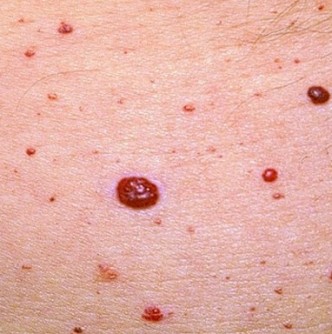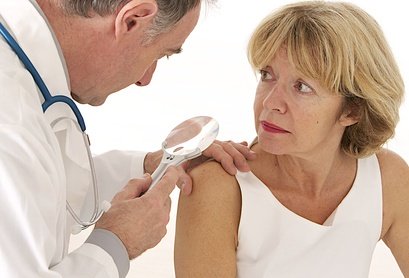
Campbell de Morgan spots, also known as Campbell de Morgan angiomas, cherry angiomas, cherry spots, and senile angiomas, are benign (non-cancerous) skin growths made of blood vessels. They get their name from the name of an English surgeon. The growths are bright red, often described as “cherry-red” (hence they are often referred to as cherry angiomas). They can appear anywhere on the body, but most often appear on the torso. They range in size from the size of a pinhead to a quarter-inch in diameter. They may be flat or dome-shaped, sticking out from the skin. They are usually painless. Often only one growth is seen but sometimes there are multiple growths.
What Causes Campbell de Morgan Spots?
No one knows for sure, but they may be hereditary. Some medical professionals think hormonal changes, like those that occur during pregnancy, can trigger the spots to appear. That’s certainly not the only thing that causes them, though, since men can get them, too. They appear most commonly in adults over the age of 30 but people of any age can get them.
How Are Campbell de Morgan Spots Diagnosed?
A doctor can usually make the diagnosis just by looking at the spots. If there is a question about the diagnosis, a biopsy may be recommended. While cherry angiomas are non-cancerous, it’s important to make sure you’re not dealing with something more serious or even cancerous.
When Should You See a Doctor?
We recommend seeing a doctor if you have red spots or angiomas that bleed frequently, that are painful or itch a lot, or that seem to be changing in color, shape, or size. See your doctor if you have other symptoms along with red spots, like a fever or body aches and pains. Of course, if you are concerned about any skin condition or have questions about your diagnosis or treatment options, you should talk to your doctor or make an appointment with a dermatologist.

How Are Campbell de Morgan Angiomas Treated?
In many cases, no treatment is necessary. However, sometimes the spots bleed frequently, or if they stick out from the skin, they may catch on things and that can cause injury and bleeding. In addition, some people are concerned about how the spots affect their appearance, especially if there are several of them and if they occur in a highly visible place, like on the face. Removal of these spots is usually recommended if they are causing a person a lot of emotional distress, even if they aren’t causing any medical problems.
If you have one or more cherry angiomas and you think you might want to have them removed, discuss your options for removal with your physician or with a dermatologist. Cherry angiomas are usually removed via some sort of minor surgical procedure, such as excision (shaving off the spot), electrocautery (burning off the spot), or cryosurgery (freezing off the spot with liquid nitrogen). Sometimes laser therapy is used instead to remove these spots. Removing multiple angiomas may take longer and cause more discomfort than just removing a single angioma.
Your physician may recommend a particular procedure for you based on the location and number of spots you have, as well as any other medical concerns you may have. Make sure to ask about the risks and benefits of each option available to you. If you’re concerned about your appearance, be sure to ask about the chances of scarring occurring as a result of removing an angioma.
There are some natural remedies you can use at home that may help reduce the spots, as well.
Our Preferred Treatment For Campbell de Morgan Spots
Our preferred treatment is the Cherry Angiomas Therapy from Naturasil. It contains a variety of natural ingredients, including a homeopathic remedy that decreases inflammation of the blood vessels and essential oils that make the spots smaller and less noticeable. It’s easy to apply and is available without a prescription. To learn more, just follow this link to the Naturasil Website.
